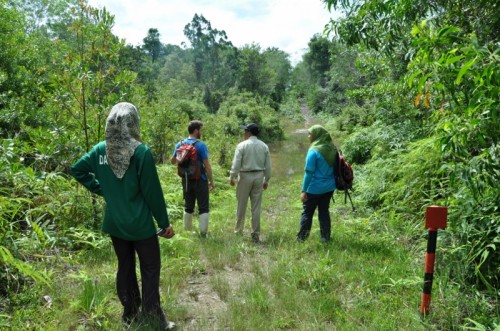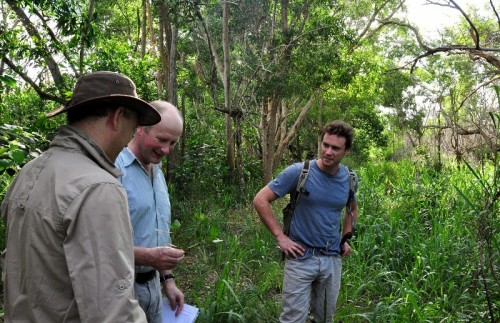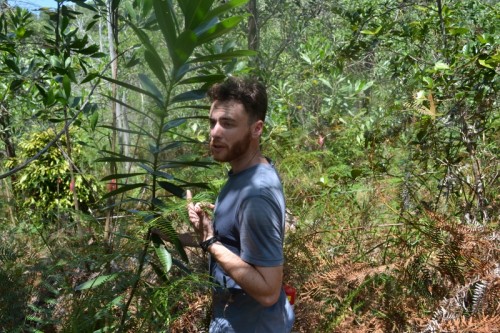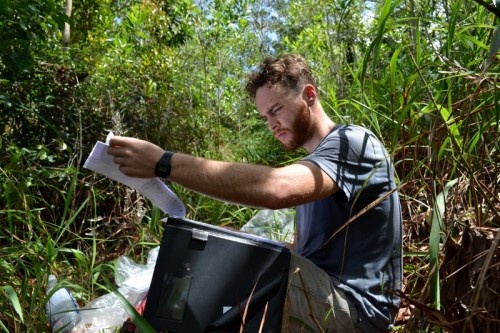18th February 2014 Bandar Seri Begawan, Brunei
The impact of invasive Acacia in conjunction with fire on the Kerangas forest of Brunei

This is a guest blog by James Margrove, a post graduate student from the University of Aberdeen, who is currently in Brunei doing an internship at the Universiti Brunei Darussalam studying the impact of invasive Acacia in conjunction with fire on the Kerangas forest of Brunei.
I was first informed about the internship opportunity with the Institute for Biodiversity and Environmental by my supervisor, Prof David Burslem from the School of Biological Sciences, University of Aberdeen. His former PhD student, Dr Rahayu Sukri, now at Universiti Brunei Darussalam had been working with him to investigate how Brunei’s forests are being changed by fire and the invasion of an exotic alien plant called Acacia.
My internship in Brunei would not have been possible without sponsorship of my visit from the British High Commission in Brunei. I am also very grateful to His Excellency David Campbell, the High Commissioner, for welcoming me to Brunei by receiving me for a fantastic dinner for visiting British Parliamentarians during my first month. My research is being supported by Dr Rahayu Sukri’s UBD research grant.
I recently finished my Masters of Biological Sciences at the University of Aberdeen, where I specialised in tropical forest ecology. Previously I had really enjoyed working in the forests in Malaysian, Borneo, where I completed two field seasons during my studies, and as a result I knew that this opportunity was too good to miss. After packing my bags and saying my goodbyes I set off from rainy Scotland for Universiti Brunei Darussalam (UBD) to extend my work into the Kerangas forests.
I am now just past the halfway stage of my 6 month field based project. The project is going really well and I have established 20 plots in disturbed and undisturbed forest to study the changes that we are observing. Very shortly the data will be ready to analyse, and hopefully we will see some interesting patterns that will give us useful inferences as to what exactly the Acacias and fires are doing to the landscape. I am working relatively independently which has given me the freedom to research what I see as the best way to answer our questions; however, having said that, I have been helped greatly in the field by interested students and local research assistants.
When not covered in mud and measuring trees I live in a small office in Institute for Biodiversity and Environmental Research (IBER) at UBD. If I have any burning questions or need any advice, my collaborators Dr Rahayu Sukri and Assoc Prof Dr Kushan Tennakoon of the IBER are helpful and never far away. My Masters supervisor, Prof Burslem, is the international collaborator on the project, and he visited UBD for the second time on 8th January 2014 to continue work with the team. I am the first research intern attached to IBER since its establishment in September 2013.
In Brunei, many are unaware of the problems associated with Acacia invasions. In the coastal Kerangas forests of Brunei, Acacia works in tandem with fire to severely degrade these unique ecosystems. Kerangas forest occurs throughout Borneo are known for its inability to support agriculture: the word Kerangas is an Iban word that roughly translates as ‘land which cannot grow rice’. These forests have not evolved to withstand burning and so recovery after fires takes decades. Acacias belong to a family of exotic trees native to Australia. Their adaptive ecology to fire allows Acacia to dominate these disturbed environments, and there is a fear that this will prevent native Kerangas’ subsequent recovery.
Why plant a non-native species in Brunei in the first place, you may ask. The answer is more practical, Acacias are prized for its quick growth and production of useful timber for furniture, making it a great choice for forestry plantations and stabilising soil after anthropogenic or natural disturbances. As a result, Acacia has been planted in environments around the globe, from Mediterranean climates in South Africa to tropical Southeast Asia. However, due to its vigorous growth, Acacia can become an invasive pest, outcompeting native flora and putting pressure on native ecosystems. Here in Brunei, my own observations suggest that Acacia, assisted by fire, is spreading and will ultimately severely degrade the forest’s biodiversity, as well as preventing regeneration of native Kerangas plant species.
My current project in Brunei investigates the impact of invasive Acacia in conjunction with fire on the Kerangas forest of Brunei. I am looking at changes in soil conditions, species compositions and light environments in localities that were formally pristine Kerangas forest. No studies as yet have investigated changes in these characteristics, and we hope that the results will provide a solid foundation for a more comprehensive assessment of Acacia invasion in Brunei Darussalam, as well as the research and development of restorative measures.



